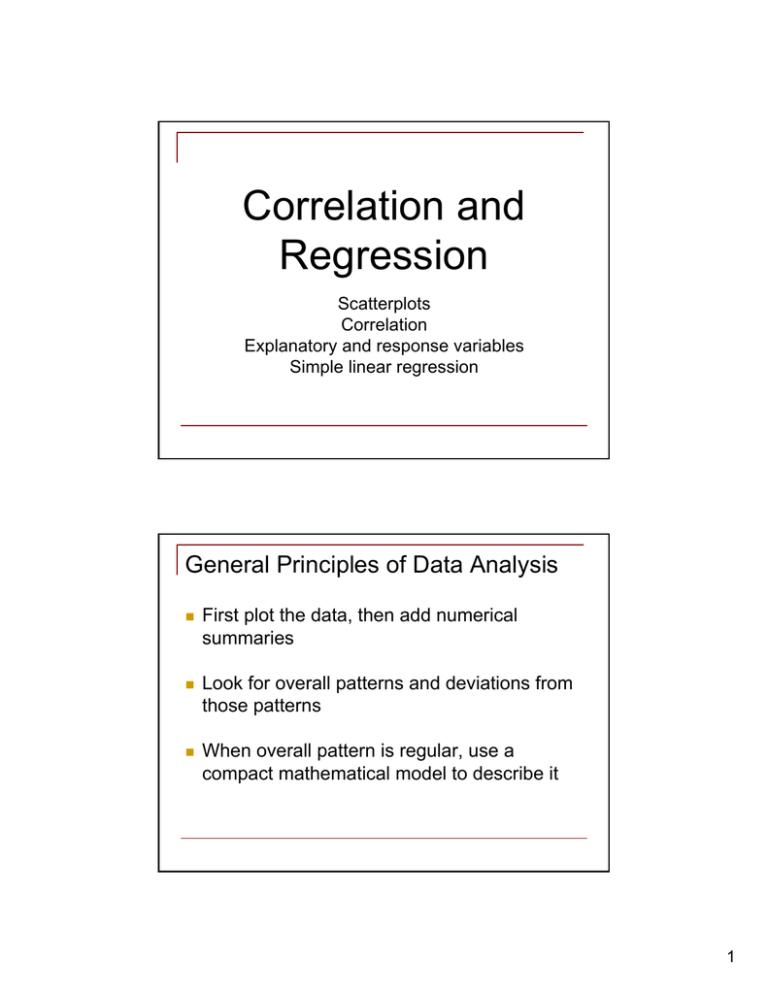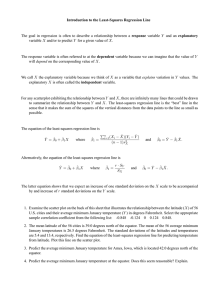Correlation and Regression
advertisement

Correlation and Regression Scatterplots Correlation Explanatory and response variables Simple linear regression General Principles of Data Analysis First plot the data, then add numerical summaries Look for overall patterns and deviations from those patterns When overall pattern is regular, use a compact mathematical model to describe it 1 General Principles of Data Analysis Plot your data To understand the data, always start with a series of graphs Interpret what you see Look for overall pattern and deviations from that pattern Numerical summary? Choose an appropriate measure to describe the pattern and deviation Mathematical model? If the pattern is regular, summarize the data in a compact mathematical model Univariate Data Analysis Plot your data Interpret what you see For continuous variable, use stemplot, histogram For categorical variable, use bar chart, dot plot Describe distribution in terms of shape, center, spread, outliers Numerical summary? Select measure of central tendency and spread: mean, standard deviation, five-number summary Mathematical model? If appropriate, use Normal distribution as model for overall pattern 2 Bivariate Data Analysis For two quantitative variables, use a scatterplot Plot your data Interpret what you see Describe the direction, form, and strength of the relationship Numerical summary? If pattern is roughly linear, summarize with correlation, means, and standard deviations Mathematical model? Regression gives a compact model of overall pattern, if relationship is roughly linear Explanatory and Response Variables Response variable measures outcome of a study Explanatory variable explains or influences change in response variable Response variables often called dependent variables, explanatory independent “Independent” and “dependent” have other meanings in statistics, so prefer to avoid But remember that calling one variable explanatory and other response doesn’t necessarily imply cause 3 Scatterplot Scatterplot shows relationship between two quantitative variables measured on same cases By convention, explanatory variable on horizontal axis, response on vertical axis Each case appears as point fixed by values of both variables Wine Consumption and Heart Attacks Some evidence that drinking moderate amounts of wine my help prevent heart attacks We have the following data from 19 countries Yearly wine consumption (liters of alcohol from wine, per person) Yearly deaths (per 100,000 people) from heart disease In Stata, use -twoway scatter- Interpret a scatterplot Overall pattern and striking deviations Form, direction, and strength Look for values that fall outside overall pattern of relationship (outlier) 4 Heart Disease Deaths (per 100,000 people) 50 100 150 200 250 300 0 2 4 6 8 Alcohol with Wine (liters per person per year) 10 Measuring Linear Association: Correlation Correlation measures direction and strength of linear relationship between two quantitative variables Usually written as r In Stata, use -correlate- or -pwcorr- Find and interpret correlation for wine and heart disease example 5 Using and Interpreting Correlation Ranges from -1 to 1; values closer to |1| indicate stronger linear relationship Positive values indicate positive association Does not distinguish between explanatory and response variables Requires that both variables be quantitative It has no unit of measurement – because it uses standardized values, it is scale free Measures strength only of linear relationships Like mean and standard deviation, strongly affected by outlying observations Least-Squares Regression Line Correlation measures direction and strength of linear relationships A regression line summarizes relationship between explanatory, x, and response variable, y We can use regression line to predict value of y for a given value of x These predictions have error, called residuals The least-squares regression line of y is the line that minimizes residuals 6 Heart disease death rate (per 100,000) 50 100 150 200 250 300 Vertical distances from least-squares line are residuals A good line for prediction makes these distances small 0 2 4 6 8 Alcohol with Wine (liters per person per year) 10 In Stata, obtain this graph with twoway (lfit heartdis alcohol) (scatter heartdis alcohol) Regression in Stata regress regress heartdis heartdis alcohol alcohol Source SS df MS Source || SS df MS -------------+------------------------------------------+-----------------------------Model | 59813.5718 1 59813.5718 Model | 59813.5718 1 59813.5718 Residual 17 Residual || 24391.3756 24391.3756 17 1434.7868 1434.7868 -------------+------------------------------------------+-----------------------------Total | 84204.9474 18 4678.05263 Total | 84204.9474 18 4678.05263 Number 19 Number of of obs obs == 19 F( 17) F( 1, 1, 17) == 41.69 41.69 Prob > F = Prob > F = 0.0000 0.0000 R-squared = 0.7103 R-squared = 0.7103 Adj Adj R-squared R-squared == 0.6933 0.6933 Root MSE = Root MSE = 37.879 37.879 slope, b ----------------------------------------------------------------------------------------------------------------------------------------------------------heartdis Coef. tt P>|t| [95% heartdis || Coef. Std. Std. Err. Err. P>|t| [95% Conf. Conf. Interval] Interval] -------------+----------------------------------------------------------------------------+---------------------------------------------------------------alcohol | -22.96877 3.55739 -6.46 0.000 -30.4742 -15.46333 alcohol | -22.96877 3.55739 -6.46 0.000 -30.4742 -15.46333 _cons 18.83 231.3733 289.7534 _cons || 260.5634 260.5634 13.83536 13.83536 18.83 0.000 0.000 231.3733 289.7534 ----------------------------------------------------------------------------------------------------------------------------------------------------------y-intercept, a y^ = a + bx Estimated heart disease death rate = 260.56 + (-22.97)(Per capita alcohol consumption) 7 Using and Interpreting Regression Distinction between explanatory and response variables is essential in regression There is a close connection between correlation and slope of least-squares line Regression of y on x ≠ regression of x on y b = r(sy / sx) Change of 1 sd in x corresponds to a change of r standard deviations in y Square of correlation, r2, is fraction of variation in values of y explained by x (PRE) Conditions for Inference Observations are independent True relationship is linear Standard deviation of response about the true line is same everywhere Response varies normally about true regression line ¾ Analysis of residuals is key to diagnosing violations of these conditions 8 -50 Residuals 0 50 Residuals-versus-Fitted Plot 50 100 150 Fitted values 200 250 In Stata, obtain this plot after regress with rvfplot, yline(0) -50 Residuals 0 50 Residuals-versus-Predictor Plot 0 2 4 6 8 Alcohol with Wine (liters per person per year) 10 In Stata, obtain this plot after regress with rvpplot alcohol, yline(0) 9 300 200 100 0 Heart disease deaths per 100,000 people 95% Confidence Interval for Least-Squares Line 0 2 4 6 8 Alcohol with Wine (liters per person per year) 10 Obtain this graph with twoway (lfitci heartdis alcohol) (scatter heartdis alcohol) 10



